|
Post Harvest Technology
|
Post Harvest
Technologies |
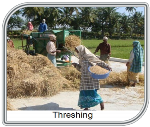 |
Threshing
- Threshing is the process of beating paddy plants in order to separate the seeds or grains from the straw.
- To maintain the high quality of the harvested grains, it should be threshed immediately after harvesting.
- Avoid field drying and stacking for several days as it affects grain quality due to over drying. Stacked grains of high moisture content results in discoloration or yellowing.
|
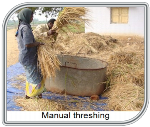
|
Threshing can be done manually or mechanically
Manual threshing
- The manual methods of threshing are treading by feet, flail method, and beating stalks against tubs, boards or racks.
- Threshing can be done by trampling using bullocks, rubbing with bare human feet (in hills) or lifting the bundles and striking them on the raised wooden platform.
- Pedal threshers are also used.
- Freshly threshed rice must be dried well in the sun.
|
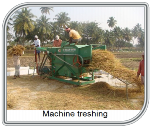 |
Machine threshing
- Mechanical threshing removes rice grains from the rice plant, speeds up threshing (thus reducing losses), and reduces labor requirements.
- Power driven stationary threshers are also used.
- Freshly threshed rice must be dried well in the sun
|
Top |
Drying
- Drying is the process of removal of excess moisture from the grains.
- Once dried, the rice grain, now called rough rice, is ready for processing.
- Proper drying results in increased storage life of the grains, prevention of deterioration in quality, reduction of biological respiration that leads to quality loss of grains, and optimum milling recovery.
Methods of drying
- Sun drying
- Mechanical drying
- Chemical drying
|
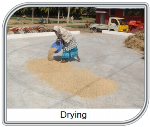 |
Sun Drying
- Sun drying is a traditional method of drying the paddy grains. Sundrying is the most economical method of drying grains.
- Grains are spread on drying surfaces such as concrete pavement, mats, plastic sheets and even on fields to dry naturally.
|

|
Mechanical Drying
- Mechanical drying process means drying the grains by ventilating natural or heated air through the grain mass to get it evaporated the moisture from it.
- Mechanical dryers are more reliable since drying could be done anytime of the year.
|

|
Chemical Drying
- Chemical drying method involves the spraying of common salt solution with specific gravity of 1.1 to 1.2 on the ears of the mature paddy crop.
- This treatment reduces the moisture content from 29% to 14.5% after four days.
|
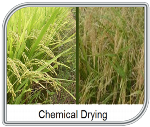
|
|
Top |
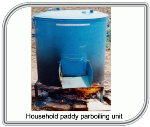 |
Parboiling
- Parboiling is a premilling hydrothermal treatment given to unhulled rice (rough rice) to improve its milling quality, nutritive value, cooking quality and storability.
- The process is accomplished in three steps: soaking, steaming and drying.
- Traditionally, parboiling was done either by single or double boiling method.
- Single boiling method involves soaking the unhulled rice in water at room temperature followed by open steaming for 20-30 minutes using iron kettles and then sun drying.
- In double streaming method, the unhusked rice is first steamed to raise its temperature and then soaked in cold water for 24-36 hrs. After soaking, it is steamed second time for 20-30 minutes followed by sun drying.
|
Milling
- Milling is the process wherein the rice grain is transformed into a form suitable for human consumption, therefore, has to be done with utmost care to prevent breakage of the kernel and improve the recovery.
- Brown rice is milled further to create more visually appealing white rice.
- After harvesting and drying, the paddy is subjected to the primary milling operation which includes de-husking as well as the removal of bran layers (polishing) before it is consumed. In this process the rice which is obtained after milling is called raw rice.
- Another process through which rice is obtained after milling is called "Parboiling Rice." Nearly 60% of the total rice produced in India is subjected to parboiling.
- Rice milling losses may be qualitative or quantitative in nature. Quantitative or physical losses are manifested by low milling recovery while low head rice recovery or high percentage of broken kernel reflects the qualitative loss in rice grains.
|
Methods of Millling :
Traditional Method
Before the advent of mechanical milling, hand-pounding traditional method of rice milling was in practice. In fact, hand-pounding rice has got more nutritive value as compared to machine milling rice. In hand-pounding, a variety of implements is used such as:
- Mortor and Pestle
- Dhenki
- Hand Stone (Chakki)
|

|
Mechanical Method
With the introduction of mechanized mills, hand-pounding method has steadily decreased because it could not compete with machine mills. The conventional mills in use can be categorized into three main types:
- Huller mills
- Sheller-Huller mills
- Sheller-Cone Polisher mills.
|
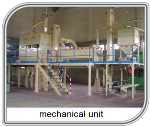
|
|
Top |


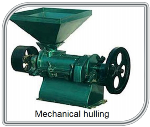 |
Cleaning and Hulling
- At the processing plant, the rice is cleaned and hulled.
- At this point, brown rice needs no further processing.
- If white rice is desired, the brown rice is milled to remove the outer bran layers. Hulling is the process to remove the hull from the kernel.
Manual hulling:
- Hulling can be done by hand by rolling or grinding the rough rice between stones.
Mechanical hulling:
- The rough rice is first cleaned by passing through a number of sieves that sift out the debris. Blown air removes top matter.
- Once clean, the rice is hulled by a machine that mimics the action of the hand held stones.
- The shelling machine loosens the hulls from the rice. About 80-90% of the kernel hulls are removed during this process.
- From the shelling machine, the grains and hulls are conveyed to a stone reel that aspirates the waste hulls and moves the kernels to a machine that separates the hulled from the unhulled grains.
- By shaking the kernels, the paddy machine forces the heavier unhulled grains to one side of the machine, while the lighter weight rice falls to the other end.
- The unhulled grains are then siphoned to another batch of shelling machines to complete the hulling process.
|
Polishing
- Polishing is the process of removal of bran layer in brown rice.
- After harvesting and drying, the paddy is subjected to the primary milling operation which includes de-husking as well as the removal of bran layers (polishing) before it is consumed.
- The rice obtained after this process is called raw rice.
|
 |
|
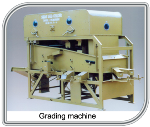 |
Quality and Grading
- Quality of rice is not always easy to define as it depends on the consumer and the intended end use for the grain.
- Grain quality is not just dependent on the variety of rice, but quality also depends on the crop production environment, harvesting, processing and milling systems.
|
Characteristics Considered for Grading of Milled Rice
- Dead rice, brokens and brewers percentages
- Defectives
- Foreign matter
- Presence of paddy
- Whiteness
- Chalkiness
- Moisture content
Objectives of establishing standards and grades
- To ensure only edible rice reaches the consumer.
- To improve post harvest practices so as to eliminate or reduce waste.
- To improve agronomic practices to increase farm yields.
- To improve processing practices for better milling recoveries and for market expansion.
- To protect consumers from price/quality manipulation.
Grades of Indian Rice
- Common variety: Short bold & long bold rice
- Fine variety: Medium slender rice
- Superfine variety: Long slender & short slender rice
|
Top |
|
Storage
Storage is the process of keeping grains, whether in bags or in bulk, in a storage structure designed to protect the stored product from inclement weather and pests for a short or long period of time to await processing or movement to other location.
|
 |
Grains are stored for either of the following reasons:
- To provide uniform supply of food throughout the year, because grains are produced seasonally while consumption is fairly uniform throughout the year.
- To provide reserve for contingencies such as flood, drought and other calamities.
- To speculate on a good price either in domestic or in the export market.
The grains are stored at three different levels, such as:
- Producer's Level
- Trader's Level
- Urban Organizational Storage Level
The methods followed for storing the grains are:
- Storage in bags
- Loose storage
- Storage in bags is convenient for short term storage, where grain is intended for very early onward movement.
- For short term storage, no control measures against insects are needed.
- In loose/bulk storage method, large quantity of grains can be stored in per unit volume of space and the infestation of insects/pests is lower.
- The basic requirements of a good storage practice are: a healthy, clean, and uniformly dried grain, and a structure that will maintain a suitable environment that will prevent pests.
|
|
|
| |
Top |
| Rice
Products |
|
By Products of Rice
- Modernization of rice milling Industry also results in production of quality by-products viz., broken rice, husk and rice bran.
- Technology is now available for the production of value- added products from these by-products.
|
Broken rice
- The broken rice is widely used in the food preparations and in the industries for making flour and in the manufacture of baby foods.
- The starch extracted from broken rice finds wider application in the pharmaceutical, textile and other industries.
|
 |
Rice husk
- Rice husk that contains about 38% cellulose and 32% lignin and is one of the most abundant renewable agriculture based fuel materials.
- The production of rice husk is about 80 million tonnes per year, equivalent in energy to about 170 million barrels of oil.
- Paddy husk contains about 22 per cent ash of which 95 per cent is silica.
- Because of its high silica content, it is used as an abrasive. Large quantities of husk are used in India as fuel for boilers, kilns and household purposes.
|
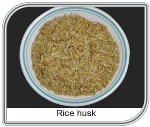 |
Rice straw
- Each tonne of paddy produces an equal amount of straw as by-products.
- Straw can be used as ruminant fodder, stable bedding material, raw material in mushroom cultivation and industrial processes like papermaking etc.
- It is also used as fuel for cooking.
- Paddy straw is used as substrate for Mushroom production. For 100 kg Mushroom production - Dry paddy straw (not more than one year old) -100 kg is required. Preparation of Substrate-Use Dried paddy straw, 500 gms per bed. Cut the paddy straw into small bits of 3 to 5 cm. and soak it in cold water for 6-8 hours. Take it out and then immerse in boiling water for 15-30 minutes and drain off excess water. Dry the straw in the shade for 2 hours and then use.
|
 |
Rice bran
- Commercially rice bran is the most valuable by-product, which is characterized by its high fat (15 to 20%) and protein content (12%).
- Because of its nutritional value, it is being used as feed for poultry and livestock.
- More stable defatted bran containing higher percentage of protein, vitamins and minerals is an excellent ingredient for both food and feed.
- It is generally contaminated with husk, which lowers its nutritive value.
|
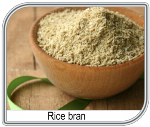 |
Rice bran oil
- Bran oil is obtained by the extraction of rice bran with solvents.
- The oil contains a high percentage of unsaturated fatty acids, yet it is quite stable because of the presence of natural antioxidants.
- When refined, bleached and deodorized, it is used for salad dressing and as cooking oil.
- Bran after solvent extraction has a higher percentage of protein than the original material. With its low fat content it keeps well.
|
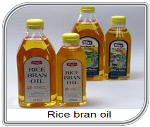 |
Importance of rice bran oil
- Rice bran oil contains components of vitamin E that may benefit health.
- The unique components, such as or tocotrienol, have been drawing people's attention.
- Oryzanol reduces the harmful cholesterol (LDL) without reducing good cholesterol (HDL).
- Tocotrienol, is highlighted as the most precious and powerful vitamin E existing in nature and is said to have an anti-cancer effect.
|
|
| Top |
VALUE ADDITION
- Processed Products
- Fermented Products Based on Rice
- Extruded Products
|
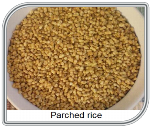 |
1. RICE - PROCESSED PRODUCT
Parched rice
- It is prepared by throwing rice in sand heated to a high temperature in an iron or mud pan.
- On stirring, rice begins to crackle and swell. Then the content of the pan are removed and sieved to separate the parched rice from sand.
- Parboiled rice is used for making grayish to brilliant white colour parched rice and sold either salted or unsalted.
|
 |
Expanded rice (Pori)
- Expanded rice (murmura, pori, muri) is a traditional convenience food widely consumed in India.
- In the traditional process, the paddy is soaked in water preferably over night until saturation, drained and then either steamed or dry roasted in sand for parboiling.
- The parboiled paddy is milled, salted and again roasted in sand for expansion.
|
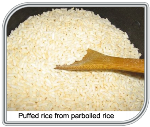 |
Puffed rice:
- This popular ready-to-eat snack product is obtained by puffing milled parboiled rice.
- In the traditional process rice is gently heated on the furnace without sand to reduce the moisture content slightly.
- It is then mixed with salt solution and again roasted on furnace in small batches with sand on a strong fire for a few seconds to produce the expanded rice.
- Rice expands about 8 times retaining the grain shape and is highly porous and crisp.
|
 |
Parched paddy or puffed paddy :(using paddy)
- Sun dried paddy is filled in mud jars and is moistened with hot water.
- After 2-3 min. the water is decanted and the jars are kept in an inverted position for 8-10 hours.
- Next the paddy is exposed to the sun for a short time and then parched in hot sand as in the preparation of parched rice.
- The parched grains are sieved to remove sand and winnowed to separate the husk.
|
 |
Puffed rice from parboiled rice
- The rice is soaked in salt water to increase the moisture to about 20%.
- The moist rice is introduced into a hot vessel at about 250-275°C for 30-40 seconds.
- The rice puffs suddenly.
|
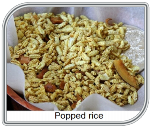 |
Popped rice
This is prepared from raw paddy. The paddy at a moisture content of 12-14% is directly roasted in iron pans using sand as a medium at a temperature of 150-200°C.
|
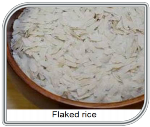 |
Flaked rice is value added product prepared from paddy.
Traditionally, it is prepared from soaked paddy, after heat treatment and immediate flattening using a flaking machine (an edge runner). Flaked rice is thin and papery and of white colour.
|
 |
Quick cooking rice is made by steeping polished rice in water to a moisture content of 35 per cent, cooking under pressure and drying.
|
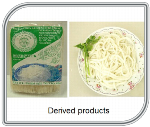 |
Derived products
Polished rice may be precooked and canned as rice pudding and also used to make dry breakfast cereals.
|
|
| |
Top |
2. RICE - FERMENTED PRODUCTS
Idli
- Idli is a small, white acid – leavened, and steamed cake made by bacterial fermentation (12-18 hours) of a thick batter made from rice and dehulled blackgram dhal.
- Idlies are soft, moist and spongy had a desirable sour flavour.
- For idli, the rice was coarsely ground and the black gram was finely ground.
|
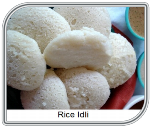 |
Dosa
- Dosa is another common fermented product used in India.
- This is prepared from a fermented batter of rice and pulse in the proportions ranging from 6:1 to 10:1.
- Both the ingredients are finely ground, unlike in the idli batter which contains the rice component in a coarse consistency.
- The dosa batter is very thin and dosa is baked on a hot pan.
|
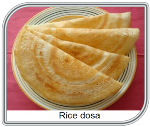 |
Other fermented products
Some other fermented foods based on rice used in the country are ambali, prepared from a thick fermented batter of finger millet flour and rice, ganji, fermented, surplus water from cooked rice and fermented rice or kali which is left over cooked rice to which water is added and the mixture allowed to ferment overnight. |
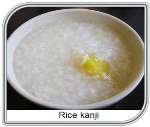 |
|
| |
Top |
| |
3. RICE- EXTRUDED PRODUCTS
- Extrusion is a process that combines several unit operation including mixing. kneading, shearing, heating, cooling shaping and forming.
- It involves compressing, and working raw material eg. Flours, starches, proteins, salt, sugar and other minor ingredients to form a semi solid mass under a variety of controlled conditions and then forcing it to pass through a restricted opening such as a shaped hole or slot at a predetermined rate.
- Heat is applied directly by steam injection or indirectly through a heated barrel.
- The final process temperature in the cooking extruder can be high as 200°C but the time of exposure to heat is relatively short (10-60 seconds).
- The extrusion cooking is also called a high temperature short time (HTST) process.
|
| |
Extruded products
- Rice based extruded products include sevai, idiappam, murukku (chakli) rice based vadagam etc.
- Rice based noodles and noodles from fermented rice flour are popular.
|
 |
Idiappam
Idiappam is a traditional food prepared from the combination of parboiled rice and raw rice. It is consumed as breakfast / dinner for the peoples especially South Indians. It is a steamed product and consumed as either in the form of sweet or savoury dish.
|
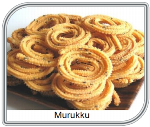 |
Murukku
Raw rice and black gram were ground in a mill separately and sieved through 80 BS sieve and used for the preparation of murukku instant mix.
|
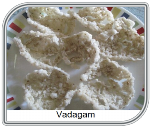 |
Vadagam
The ingredients were mixed and 250 ml of water was added and cooked for 10 minutes until a thick extrudable paste was formed. The hot paste was extruded in hand extruder (dia 5 mm) and dried in sun for about five hours. The dried vadagam sample was packed in a polyethylene bags and sealed.
|
|
| Top |
|
Processing
Machinery Suppliers |
1. Aurosimon
Company Profile
Manufacturer of Food Processing Machinery for Cleaning and Milling Machines for Cereals Nursery bed preparation
Main Markets : Asia
Annual Sales : Below US$1 Million
Business Type: Manufacturer
Contact Us
M.M.Patel
Villupuram District, Via Pondicherry T C BALAM
Villupuram 605111
Tamil Nadu
India
Phone: 91-413-2671341/2332017
Fax: 91-413-2267629 |
2. Buhler (India) Ltd.
Company Profile
Manufacturer of Complete Plant Machinery and Equipment for Food Grains and Food Processing Industry.
Business Type : Manufacturer
Main Markets : Australia, East Europe, West Europe, Middle East, North America, South America, Asia, Africa
Annual Sales : Below US$1 Million
Contact Us
Dipak Mane
13-D, KIADB Industrial Area, Attibele
Bangalore 562107
Karnataka
India
Phone: 91-80-27820000, 27820315
Fax: 91-80-27820001 |
3. Fowler Westrup (India) Pvt. Ltd
Company Profile
Manufactures Nirmal Filters. NIRMAL FILTERS are available in capacities ranging from 200 to 12,000 liters per hour.FWL also Manufactures Pre-Cleaners, Fine Cleaners, Gravity Separators, De-Stoners, Conveyors, Bucket Elevators for Processing Hybrid Seeds.
Business Type : Manufacturer
Main Markets : Asia, Africa, Australia, East Europe, West Europe, Middle East, North America, South America
Annual Sales : Below US$1 Million
Contact Us
Kilar B. Vijaykumar
Plot No.-249 & 250, Bommasandra Industrial Area, 3rd Phase
Bangalore 560099
Karnataka
India
Phone: 91-80-7832991
Fax: 91-80-7832990
|
4. Sri Manjunatha Industries
Company Profile
Sri Manjunatha Industries (Srimi) / Entel Electronics Pvt. Ltd. is one of the leading industries in Design and Manufacture of various types of Food Processing Machineries as Hammer Mills, Destoners, Coating Machine and UV Curing machines.
Business Type : Manufacturer, Exporter
Year Established : 1990
Main Markets : Africa, Australia, East Europe, West Europe, Middle East, North America, South America, Asia
Products
Food Processing Machineries
Design and Manufacture of various types of Food Processing Machineries as Hammer Mills, Destoners, Coating Machine and UV Curing machines.
Contact Us
Lokanath Reddy
# 1 & 2, II Main, Garudachar Palya Opp. V.S.T. White Field Road, Mahadev Pura (Post).
Bangalore 560048
Karnataka,
India
Phone: 91-80-51157678,
Fax: 91-80-51157678
|
5. Emmppe Associates
Company Profile
Importers of Rice Mill Machinery.
Business Type : Importer
Main Markets : Asia
Annual Sales : Below US$1 Million
Contact Us
A. Magesh Kumar
2/368-A, Irugur Road, Chinniampalayam
Coimbatore 641001
Tamil Nadu
India
Phone: 91-422-2629655
Fax: 91-422-2629930 |
6. KIRORIMAL KASHIRAM
Company Profile
Importers of Machinery, Rice Machinery
Importers of Rice Mill Machinery.
Business Type : Importer
Main Markets : Asia
Annual Sales : Below US$1 Million
Contact Us
Arun Kumar Agarwal
60, Anderson Street
Chennai 600001
Tamil Nadu
India
Phone: 91-44-25383646/25386785
Fax: 91-44-25364711 |
7. R. R. Engineers
Company Profile
We are Manufacturer of Flour Mills Machinaries
Business Type : Manufacturer
Main Markets : Asia
Annual Sales : Below US$1 Million
Contact Us
A Remigius
11/74, Sridevi Nagar, Koundampalayam
Coimbatore
Tamil Nadu
India
Phone: 91-422-6524389
|
8. G. G. Dandekar Machine Works Ltd.
Company Profile
Manufacturer & Exporter of Paddy Drycleaner for Cleaning Grains, Pneumatic Rubber Roll Sheller (Automatic Paddy Husker) for Shelling Paddy, Parboiling & Drying Plant, Husk Separator.
Business Type : Manufacturer, Exporter
Main Markets : Asia
Annual Sales : Below US$1 Million
Contact Us
Atul Kirloskar
Dandekar Wadi, Bhiwandi
Thane 421302
Maharashtra,
India
Phone: 91-252-2229870, 2229871,
Fax: 91-252-2229873 |
9. Guru Nanak Engg & Foundry Works
Company Profile
Manufacturer & Exporter of Rice Mill Machinery.
Business Type : Manufacturer, Exporter
Main Markets : Asia
Annual Sales : Below US$1 Million
Contact Us
Sharanjit Singh
166, Industrial Area, Focal Point, Mehta Road
Amritsar 143001
Punjab
India
Phone: 91-183-2587943, 2583542
Fax: 91-183-2587944
|
10. R. Shunmugam Pillai & Sons - India
Company Profile
We are the wholesale suppliers of all kinds of food processing machinery, flour mill machinery, flour mill accessories.
Business Type : Manufacturers / Merchants/Traders
Contact Us
7, Eduka Mosque Lane, (chellandiamman Koil St.),
Palani Road,
Dindigul,
Tamil Nadu, India
|
| |
Top |
|